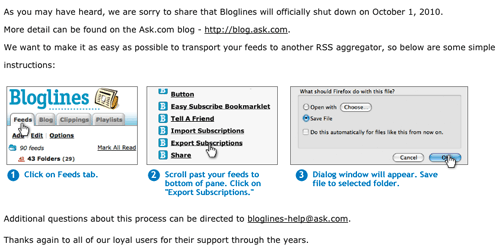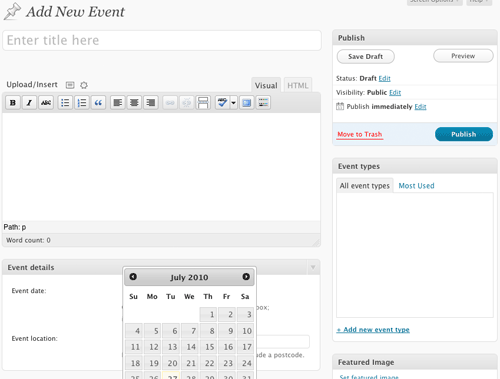
As a long-time user of Bloglines, it’s been pretty clear that the veteran online RSS reader was suffering from a lack of love lately. More often than not, when you hit the URL, you got an error message: two or three refreshes each time wasn’t unusual. The ‘beta’ version of its next incarnation showed no sign of reaching a full release.
But even so, it came as a bit of a shock over the weekend to learn that Bloglines was being closed down.
I’ve moved almost my entire online life to Google products – and yet, I never abandoned Bloglines for Google Reader. Hard to put a finger on why, really. I never really warmed to Google Reader, with all its bells and whistles… whilst Bloglines stuck doggedly to what it was good (enough) at. I particularly liked its stripped-back mobile interface, which allowed for ‘one click to download everything’ reading: perfect for long train journeys through patchy 3G coverage.
The justification comes on the blog of its parent, AskJeeves.com – which, yes, is still going.
The Internet has undergone a major evolution. The real-time information RSS was so astute at delivering (primarily, blog feeds) is now gained through conversations, and consuming this information has become a social experience. … Today RSS is the enabling technology – the infrastructure, the delivery system. RSS is a means to an end, not a consumer experience in and of itself. As a result, RSS aggregator usage has slowed significantly, and Bloglines isn’t the only service to feel the impact. The writing is on the wall.
I’m not sure how to feel about that. You see, before I became obsessed by WordPress, I was obsessed by RSS. Indeed, its approach to RSS was one of the reasons I fell for WordPress in the first place. Yet I still don’t think the usefulness of RSS is widely appreciated.
I don’t agree with the Ask.com blog, which says its place has been taken by Twitter and Facebook: that seems a very individual-centric perspective. That may be true for blogs specifically, person to person; but I don’t think it holds true for larger-scale publishing – website to consumer, or indeed, website to website. I always wondered if the name Bloglines was holding the product back: perhaps this is proof.
So, farewell Bloglines. It was fun while it lasted. I still don’t want to switch to Google Reader – but I need a solution which works seamlessly across iPhone, Android, Mac, Windows, Linux, everything. I’m not sure there’s any serious alternative to Google Reader now… but the immediate plan is to experiment with the various platform-specific clients which sync with it. Recommendations, anyone?


 I couldn’t help smiling at the
I couldn’t help smiling at the